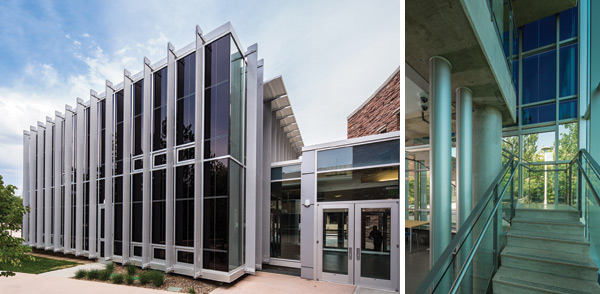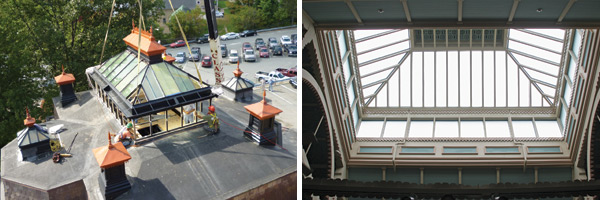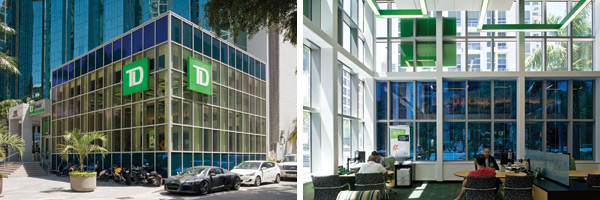Controlling Daylight in Buildings
Electrochromic glazing offers a truly dynamic and affordable solution
![]() Continuing Education
Continuing Education
Use the following learning objectives to focus your study while reading this month’s Continuing Education article.
Learning Objectives - After reading this article, you will be able to:
- Identify and recognize the common options to design daylighting into a building design.
- Investigate the factors that increase or decrease energy use by using glazing in buildings for daylighting and other purposes.
- Assess the technology and operation of electrochromic glazing as used in buildings.
- Describe the different methods of solar and daylight control that are possible through the use of electrochromic glazing.
Le Corbusier is attributed with saying “Architecture is the masterly, correct, and magnificent play of masses brought together in light.” It would appear this viewpoint on the relationship of architecture with light continues to influence us today. In 2012, an independent media survey of nearly 500 architects showed overwhelming agreement that providing and controlling natural light is an important design concern. When drilling down as to why, the reasons go beyond just the aesthetic into the way people interact with spaces. More than 99 percent of the architects surveyed believe people perform their jobs or activities better in buildings when exposed to natural light. Additionally, almost 98 percent of these architects felt occupants perform better when they have a view and connection to the outdoors.
However, uncontrolled, abundant sunlight can adversely affect building occupants as much as it benefits them, with problems such as glare, heat gain, and fading. Hence more than 93 percent of architects surveyed also agree that sun control is a significant challenge when designing glass into buildings. Finding the balance between the benefits of natural daylight while controlling for the problematic issues is a design challenge on every project. Understanding the principles of lighting and control while finding the right tools to address them allows for “masterly, correct, and magnificent” results to be realized.
Daylighting Overview
In addition to the human benefits of natural light, the ongoing need to reduce energy use in buildings has encouraged increased use of daylighting. By incorporating natural daylight into buildings, the intent is to turn off some, if not all, of the electric lights in a daylit space. This creates a direct reduction in the electricity purchased for lighting but also creates a ripple effect of indirect benefits. Electric lights generate heat which in turn raises the temperature of the spaces where they are installed. If that space is being air conditioned then more energy is being used for air conditioning when the electric lights are on but less when they are able to be turned off. This affects the direct amount of electricity purchased (i.e. kilowatt hours) and the direct cost of that electricity paid for by the owner or occupant. In addition, it can reduce the other part of most commercial electric utility bills, namely the peak demand charge. Utilities base this charge on the highest average spike or peak of total consumption that a customer uses over a prior billing period (i.e. a year or so). In many buildings, that peak is reached when the building is fully occupied, all the lights are on, and it is a hot day, meaning that the air conditioning is running at full capacity. Using some appropriate design strategies, daylighting can be used to turn off the lights, reduce heat build-up, allow the air conditioning to run at a lower level, and ultimately reduce peak demand.
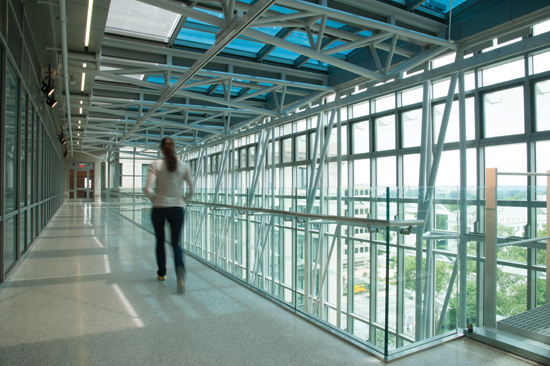
Image courtesy of SAGE Electrochromics, Inc.
Natural daylight can be incorporated successfully in a variety of building types to provide benefits for people and to reduce energy use in buildings.
The ability of daylight to produce all of these positive outcomes first requires attention to the design of the building. The not-for-profit organization known as Architecture 2030, led by architect Ed Mazria, has developed a tool to help architects understand many different aspects of building design that affect its energy performance, including daylighting. The tool is known as the 2030 Palette and is available online at no cost (www.2030palette.org). It is a succinct and useful design resource that offers information broken down by individual topics (referred to as “swatches”) ranging from regional scale down to building scale. Each topic contains a summary of the concepts, some rules of thumb for initial design, photos of example projects, a list of publications for additional information, and links to related topics. Some of this information related to daylighting is summarized in this course.
Building Form for Daylighting
The basic shape of a building will impact its ability to use daylighting effectively. Hence, when developing a building shape, consider how best to admit daylight into the building. Building shapes with a narrow floor plate will maximize exterior wall areas to incorporate glazing. These shapes can be elongated, curved, or combinations of multiple shapes. Deep buildings with large floor plates can use atria and courtyards in order to bring daylight into the inner realms of the building. Low-rise and one-story structures have more opportunities for daylighting by using the roof as a daylighting source, thus allowing more shape options.
Some rules of thumb for creating a building form to maximize daylighting include:
• Develop the building shape and floor plates by locating occupied spaces using the 15 / 30 foot rule for typical story heights: Create a 15-foot perimeter zone depth for task daylighting and an adjacent 15-foot zone for ambient daylighting.
• Make the north and south sides of the building longer and more exposed for controlled daylighting by elongating the form in the east-west direction.
• Use high ceilings and windows to allow for greater penetration of daylight into the interior. Sloping the ceiling from the high window side down to the interior may help with penetration and distribution as well.
Side Daylighting
The building shape and size will determine whether side daylighting can be achieved on just one side or on multiple sides. Daylighting spaces from multiple sides provides more even lighting while producing less glare. This can be achieved by providing glazing on adjacent or opposite walls or by providing a combination of side daylighting and top daylighting strategies. Spaces daylit from only one side will need to be assessed to avoid a steep light gradient between the daylit side of a room or space and the unlit side. Spaces improperly daylit from one side may contain excessive differences in brightness, intense contrasts, and uncomfortable glare conditions.
Some basic rules of thumb for successful side daylighting include:
• Acceptable interior task-daylight levels can be achieved at a depth of 1.5 to 2 times the height of a glazed opening in an exterior wall.
• A light shelf added to a glazed opening will reflect daylight deeper into a space, and can increase the daylighting depth to 2.5 times the height of the glazed opening.
• Size the glazing area as a percentage of the floor area of the space to be daylit. For minimum or ambient lighting, use a glazed area that is equal to 10 to 15 percent of the floor area. For more adequate or task lighting, size the glazing to be 15 to 25 percent of the floor area (or 25 to 40 percent of the exterior wall area).
• Make the side walls, back wall, and ceiling a light color to evenly distribute daylight and prevent glare.

Images courtesy of SAGE Electrochromics, Inc.
LEFT: The shape or form of a building can be used to optimize the exposure of interior spaces to use beneficial daylight.
MIDDLE: Side daylighting is a legitimate strategy for bringing natural light into perimeter zones of a building.
RIGHT: Top daylighting is an effective method to bring abundant natural light into interior building spaces.
Top Daylighting
Allowing daylight to enter a space from above rather than the side of a building is extremely effective. The Romans understood this by incorporating an oculus into roof domes, such as the Pantheon, which adequately illuminated the entire space below. Modern warehouses and big box retail stores use small skylights spread across the roof to effectively illuminate large spaces. All of this works because top daylighting gives access to the entire skydome with brighter and more direct daylighting across the day. It also allows better distribution of light inside the space just as an electric light is more effective on the ceiling compared to being on the wall. Top daylighting creates a more consistent distribution of daylight, sometimes allows for easier glare control, and for penetrating deeper into the interior of a building.
The general rule of thumb for top daylighting is to make the daylighting glazing area a minimum of 10 percent to 20 percent of the floor area to be daylit. Too little area can create excessive contrast and glare while too much area can overwhelm the space with light. Either way, filtering and distributing the light is beneficial, particularly in critical task areas to avoid direct rays of sunlight from interfering with day-to-day activities.
Daylighting Balance
Whether side daylighting, top daylighting, or a combination is used in a particular building project, the design challenge of balance and control is critical to a successful outcome. Daylighting has direct impacts on things beyond the provision of natural light and views. If the light is too intense or creates too much of a contrast within a space, then it will be regarded as uncomfortable glare that is not welcome by the occupants. The constant exposure of materials and finishes to sunlight can also cause colors to fade and materials to break down. But perhaps the biggest balance issue is the fact that the solar light entering the space also brings solar heat with it, all year long. That solar heat may be welcome in cool weather, contributing to greater occupant comfort while using less purchased energy for a mechanical heating system. However, during warm weather or in buildings that tend to require more cooling than heating, increased daylighting can bring an unintended penalty of too much solar heating, thus making people less comfortable, causing more air conditioning to run, and consume more energy—all the opposite of our original design intentions.
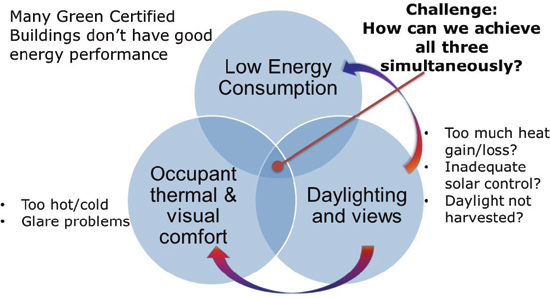
Image courtesy of SAGE Electrochromics, Inc.
A pictorial representation of the challenge of green building design: how to optimize both energy efficiency and daylighting and views without compromising occupant comfort.
The key to good daylighting design in buildings, then, is to find ways to maximize the positive benefits of daylight and solar gain while minimizing the negative possibilities of glare, fading, and energy penalties. Conventional design approaches to find that balance have included some very specific strategies.
Side Daylighting Control
Direct sunlight coming through a window onto critical task areas (e.g., work areas, desks, TV monitors, computer screens, reading areas, etc.), and the presence of high brightness in the field of view, cause a high degree of unwanted contrast between surfaces or uncomfortable glare. Conversely, shielding the direct line of sight to the sun reduces the contrast between surfaces and prevents glare. In order to block the direct line of sight to the sun the following strategies are common:
• For glazing on the east and west sides of a building, horizontal or vertical louvers can be applied to the building either on the internal or external side of the wall. External louvers are usually fixed in place and fabricated out of aluminum or other durable materials. Internal louvers may include single or multiple light shelves, adjustable blinds, or similar products. Any of these can reflect light into the space and cause it to disperse, however they will likely interfere with the view out of the windows.
• For solar glazing that is facing the equator (for maximum solar heat benefit), horizontal light shelves or horizontal louvers installed either on the internal or external side of the wall work better than vertical ones. An exterior louvered overhang above solar glazing allows more daylight into a space while also blocking unwanted summer sun.
• For other general glazing facing the poles, vertical louvers will work well to disperse the sunlight for most of the day.
For most side daylighting situations, these are the most common strategies even though they add cost to a daylighting project. It is important, of course, to remember that the goal is to disperse and distribute sunlight so louvers and light shelves need to be a light or reflective color in order to do so. Adjustable blinds and louvers allow great flexibility provided they are actually used properly on a day-to-day basis, either manually or automatically. They also need to be cleaned and maintained to reflect and operate properly.
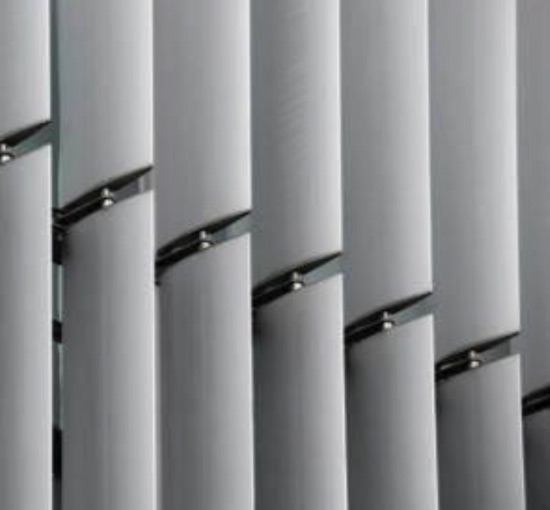

Images courtesy of SAGE Electrochromics, Inc.
Conventional means of controlling daylight include vertical and horizontal louvers or baffles placed to re-direct and diffuse direct sunlight.
Top Daylighting Control
As with side daylighting, direct sunlight from clerestories, skylights, or roof monitors can create uncomfortable conditions and excessive brightness in critical task areas. Adding reflective architectural elements that act as direct sunlight diffusers will reduce glare and create softer, more uniform daylighting levels. Some common strategies to do this include:
• Incorporate horizontal, vertical, or angled light-diffusing baffles, light shelves, or banners to intercept, soften, and distribute direct sunlight.
• Reflect sunlight onto high portions of an interior wall to eliminate bright patches in the field of view.
• Use diffuse glazing or reflect direct sunlight off the sidewalls of skylights or clerestories.
• Shade clerestory and skylight glazing from direct sunlight in summer to reduce solar heat gain.
High-Performance Glass
There have been a series of advancements in glazing technology in recent years that allow for the selection of glass that has different thermal and light transmittance properties. The key to controlling and balancing the light and heat coming through glazing is found in the characteristics of that glazing. There are two commonly used measures that have been developed and used widely in the glazing industry.
• Visible light transmission (VLT): All glazing reflects or absorbs some light and allows the rest to pass through it. The VLT is simply the percentage of the visible light spectrum transmitted through glazing and perceived by the human eye. Very clear glass could have a VLT of 90 percent or better while dark, heavily tinted glass could have a VLT of 20 percent or less. Standard low emissivity glass (low-e) typically has visible light transmission of about 40 to 60.
• Solar heat gain coefficient (SHGC): All glazing similarly reflects or absorbs some heat and allows for the rest to impact the building as heat gain. The SHGC is simply the fraction of total solar radiation admitted through glazing. It is expressed as a decimal number between 0.0 and 1.0 such that the lower the SHGC, the less solar heat gain allowed by the glazing.
Commonly, the higher the percentage of VLT in glazing, the higher the value of SHGC, or simply put, more light usually means more heat. Conversely, lower VLT reduces solar heat gain, but it also restricts natural daylighting. Hence, building designers need to assess the building conditions to determine the most appropriate values for each of these two characteristics. The challenge is that once the particular glass is selected and installed, it is a fixed or “static” solution. Static solutions are permanently clear or tinted or reflective regardless of changing seasons or sunlight conditions. This static trait means that interior or exterior controls, as described previously, will still be desired in many cases to account for changing light conditions during a day or season. It also means that any given window will likely be designed for an average condition or a worst-case condition and thus not be able to effectively address the full range of variable conditions in the building associated with heat gain, glare, and damage to materials.
Dynamic Glazing Technology Breakthroughs
Given the need to keep the benefits of glazing and overcome the limitations of conventional control strategies, a number of emerging technologies have been applied to glazing that provide “dynamic” rather than “static” control options. Simply defined, dynamic glass can respond to changing light conditions by clearing or darkening as light levels change. Some examples include photochromic or thermochromic glass that respond to UV light or heat and automatically tint the glass accordingly. This type of dynamic glazing requires no electricity and has been used most commonly in products like eyeglasses causing them to darken in bright light and clear in less light. A different type of dynamic glass is privacy glass. Specifically designed for interior applications, privacy glass generally requires 110 volts of AC electricity and is a laminated glass with organic compounds placed between the layers making them either a Suspended Particle Device (SPD) or a Liquid Crystal Device (LCD). In either case the glass is made clear when the electricity is turned on and reverts to its natural opaque state when the power is turned off.
Electrochromic Glazing
One type of dynamic glazing technology specifically designed for building envelope applications is referred to as electrochromic (EC) glazing. This technology uses a series of thin, non-organic films deposited onto the surface of glass that can be electrically charged to reduce both light and heat transmission through the glass. Unlike SPD or LCD glazing, however, the amount of electricity used is dramatically less, typically at less than 4 volts DC and less than 10 milliamps. Further, the electric charge is only needed to tint the glass, since the natural state of EC glazing is clear. Through variable tint control settings, electrochromic glazing preserves the human benefits of abundant sunlight, views, and connection to the outdoors but without the associated issues and environmental penalties. This makes it one of the most promising forms of dynamic glazing available today for building applications. Electrochromic glass has been installed in hundreds of installations and is gaining significantly more interest from architects and designers due to its highly controllable, “dynamic” nature.
EC glazing is made from panes of conventional float glass that are sputter coated with ceramic layers of metal oxides. The specific processes are proprietary to the manufacturers, but are similar to the way low-e glass is produced. In most cases, nanotechnology is used to control layers to a very fine degree. The total thickness of all the layers of an electrochromic coating is commonly less than 1/50th of the thickness of a human hair. When a small electric charge is electronically applied across the coatings, ions travel between layers, where a reversible solid state change takes place, causing the coating to tint and absorb light. Reversing the polarity of the applied voltage causes the ions to migrate back to their original layer, and the glass returns to its clear state.
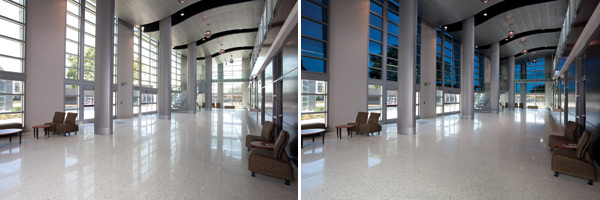
Images courtesy of SAGE Electrochromics, Inc.
At Chabot College in Hayward, California, designers wanted to incorporate as much glass as possible to flood the interior with daylight and keep a connection to the outdoors. Electrochromic glass was used (clear on left and tinted on right) instead of mechanical shades or blinds in order to retain the view and keep the openness of the space.
The coated panes of glass are fabricated into insulating glass units (IGUs) using another piece of glass (clear, tinted or laminated) and a stainless steel spacer. These IGUs can be fashioned into windows, skylights, and curtain walls, making advanced electrochromic glazing as easy to specify and install as conventional static glazing. The control mechanisms to affect the dynamic tinting changes can be manual or automatic, but either way, most of the tinting occurs in 7-15 minutes, depending on glass size and temperature of the glass. Faster tinting can occur in smaller panes and/or warmer temperatures.
The beauty of the installed system is that since the glass itself is controlling solar light and heat, there is no need for exterior or interior shading or other solar devices to be built, purchased, or installed. Therefore, it integrates easily into any design, and into ordinary construction processes as part of a glazing installation without the added time or expense of other control measures
Electrochromic Glazing Performance
With dynamic EC glazing, both VLT and SHGC are variable and adjustable on demand meaning that the building can respond to different daylight conditions, relieving the designer from having to select only one set of static glazing values. As a practical matter, however, it should be pointed out that the variability is commonly controlled at four pre-set points:
• A dark setting to eliminate almost all light at 1 percent VLT and a corresponding highly reflective SHGC around 0.09.
• A low intermediate setting at approximately 6 percent VLT / 0.10 SHGC still with high light control and low heat gain.
• A middle intermediate setting at 20 percent VLT /0.15 SHGC allowing more light and a little more heat gain.
• A clear setting (i.e. no electrical charge) of approximately 60 percent VLT with 0.42 SHGC to allow the most light but still provide good solar heat gain control.
These settings meet most typical conditions to preserve the view and connection to the outdoors no matter the time of day or time of year. By adjusting to outdoor conditions, they allow full lighting when desired or can tint down incrementally to reduce glare, discomfort, and fading. It also optimizes energy use in the building by rejecting solar heat gain when it is not wanted, and allowing it in when it is desirable or acceptable.
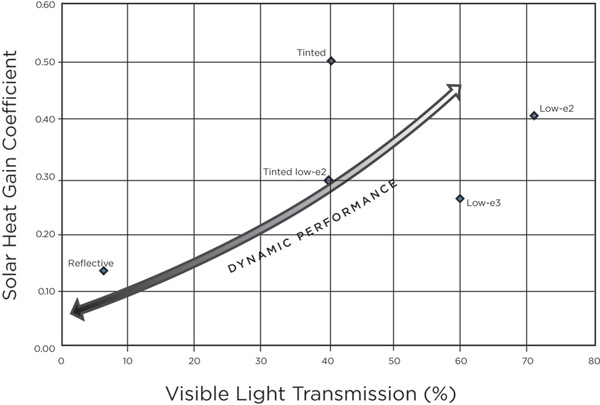
Image courtesy of SAGE Electrochromics, Inc.
Static glazing will have only one set of VLT and SHGC performance characteristics. Dynamic glazing has a controllable range of those characteristics to suit changing conditions in buildings.
Although electrochromic glazing is a unique technological innovation, it has been shown to be a cost-effective solar control system. When compared to traditional solar control solutions, such as low-e glass with blinds or mechanized sunshades EC glazing is cost competitive or even cost neutral. Regarding the operation of the EC glazing it should be stressed that due to its electronic nature, it uses minimal electricity. To put things in context, 2,000 square feet of EC glazing (approximately 100 windows) has been shown to be controllable using less power per day than one 60-watt light bulb. Hence, in exchange for a very minimal energy use, much more energy use can be offset and large potential net savings realized. Photovoltaic (PV) solar cells could also be a source of that energy, making the glazing a fully net-zero energy user. EC glazing requires only low DC voltage and power consumption, making them an excellent candidate for PV power, particularly since there would be a direct relationship between the amount of sunlight available to provide the power and the level of tinting required.
The overall building energy results of a properly installed EC glazing system are realized in several ways. First, it has been demonstrated to reduce overall energy loads (heating, cooling, and lighting) by up to 20 percent by controlling the daylight and solar heat gains of a building. The U.S. Department of Energy (DOE) is even more optimistic in its estimate that electronically tintable window systems are capable of providing up to 40 percent savings on energy bills and 20 percent on operating costs. Secondly, EC glazing can have a ripple effect by lowering peak electrical demand power requirements by up to 30 percent saving some building owners a considerable amount of money beyond pure consumption costs. Thirdly, when used as part of an effective overall daylighting strategy, it can lower electrical lighting costs by up to 60 percent. Finally, all of those load reductions means that EC glazing can reduce HVAC equipment sizing and first costs by up to 25 percent compared to conventional building designs.
Looking at the bigger picture of energy consumption and CO2 emissions, utility companies commonly run their most efficient power plants to meet base load demand and slowly bring on less efficient, more CO2 emitting plants as demand increases. The increased electricity demands are most common during hot weather periods with abundant sunshine. Electrochromic glazing reduces the building loads during these peak utility times thus directly contributing to reducing power plant emissions. In full building installations, electrochromic glazing can reduce peak load carbon emissions by as much as 35 percent in new construction and 50 percent in renovation projects.
Controlling Daylight with Electrochromic Glazing
There are two basic ways to maximize comfort and performance with electrochromic glazing. The first is to define appropriate control strategies and the second involves breaking the glazing into zones.
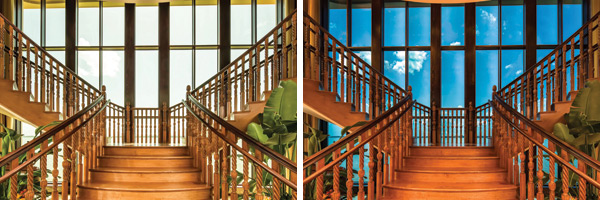
Photos courtesy of SAGE Electrochromics, Inc.
The Pavilion on the Lake in Tavares, Florida, installed EC glazing on three sides of the facility to control sunlight and glare while reducing energy costs and maintaining the stunning waterfront views. (Clear on left and tinted on right).
Control Strategies
Control strategies determine when the glazing will be in its darkened, clear, or intermediate states. They include daylight control, schedule control, and glare control. Each can be addressed individually or they can be combined into one overall strategy depending on the building and application. An electronic control system is integrated with the installed glazing and can be customized depending on the needs of the project. This control system can receive automated commands from other devices such as a daylight sensor, occupancy sensor, or sensors tied into a central Building Management System (BMS). Commands to tint or clear can also be given manually by using wall switches or similar devices. Either way, depending on the sky conditions (cloudy vs. clear), and sun position, the control system will receive the commands to control tint level to achieve the optimum foot-candle level for the daylit space. With overcast skies, the glass may be cleared to admit enough daylight to achieve optimum illumination within the space. With clear skies, the control system can darken or partially tint the IGUs to limit daylight to obtain the same foot-candle target, while concurrently reducing solar gain. By using multiple sensors in multiple locations, the tint level can be linked directly to the amount of daylight or solar gain desired in any particular space. The control system calculates the angle of the sun based on the time of year (or day) and photo sensor inputs allow for the system to optimize the daylight and amount of solar energy desired in the space. Daylighting controls based on seasonal variation can block solar gain in summer to reduce air conditioning loads, or allow more solar gain in winter to reduce heating needs.

Photos courtesy of SAGE Electrochromics, Inc.
Zoning of windows with EC glazing allows for a full range of control within a single room or an entire building.
Glass Zoning
Glare control strategies will play directly into the overall tinting control strategy. Tinting the glass fully (to 1 percent VLT) will achieve occupant comfort in direct sunlight or intense reflected light. It is important to note that all individual window panes do not need to be reduced to that level. Rather, the user can also control the glazing through zone control strategies which allow groups or “zones” of windows to be tinted while others can be clear. This is possible because windows and skylights with electrochromic glazing are highly programmable down to each individual pane of glass.
For example, since the sun's glare is directional, EC glazing can be programmed to “track” the sun as it moves around the building. With more zones come a greater number of opportunities to optimize and balance glare, daylighting and energy issues. Alternatively, individual rooms or spaces can be zoned to allow horizontal rows of glazing to respond together such that an upper or lower row(s) can be tinted to block glare where needed while other rows can be left clear. By comparison, static windows in commercial buildings typically transmit around 40 to 50 percent visible light, thus the need for additional shading devices. With static glass, the only way for an occupant to control glare is to pull the shade or blinds which are rarely reopened at the optimized time for energy efficiency. This situation negates the benefits of the window and decreases the effectiveness of any daylighting strategy including electric lights getting turned on that might otherwise have been kept off. By using dynamic EC glazing instead, windows can be dimmed down to 1 percent VLT eliminating glare without blocking the view outdoors. When glare is removed, occupants can see their computer, tablet, phone, TV screens and still see the view out of their window.
Conclusion
The impact of being able to create successful daylighting designs without energy or comfort penalty should not be underestimated. Using proper design principles, architects can create buildings of all types that harvest available daylight for attractive light, views to the outdoors, and contribute to the general well-being of the occupants. By incorporating the available technology of dynamic electrochromic glass, the age old issue of how to control this daylight is elegantly and cleanly solved. The EC glass can be controlled to respond to different lighting conditions in different parts of the same building or even the same room at different times of the day, the month, or the year. The end result is a more appealing space that has the potential to use less purchased energy every day over the life of the building.
Peter J. Arsenault, FAIA, NCARB, LEED AP, is a nationally known architect, sustainability consultant, technical writer, and continuing education presenter. www.linkedin.com/in/pjaarch
 |
SageGlass®, a product of Saint-Gobain, is advanced dynamic glass that can be electronically tinted or cleared to optimize daylight and improve the human experience in buildings. With SageGlass you can control sunlight and glare without shades or blinds while maintaining the view and connection to the outdoors. SageGlass is manufactured in Faribault, MN, in the heart of the “Silicon Valley of the window industry,” and is a wholly owned subsidiary of Saint-Gobain of Paris, the world's largest building materials company. www.sageglass.com |

